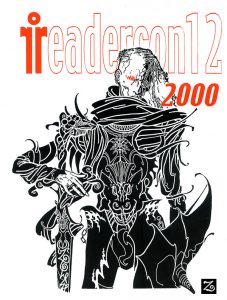Of A Neophyte and How The Black Art Is Revealed Unto Him
ALAN MOORE & STEVE MOORE. The Moon and Serpent Bumper Book of Magic. Sherman Oaks, CA: Top Shelf Productions and London, UK: Knockabout Comics, 2024. 350 pp. $49.99 hc. ISBN (US): 9781603095501.
Once on a time
There was a little boy: a master-mage
By virtue of a Book
Of magic—O, so magical it filled
His life with visionary pomps
Processional!
O, so magical gilt & empurpled gift to All!
A cheery chappie clutching caduceus and an Upper Arcana Magician from the Thoth Deck greets one on the cover. Physically reminiscent of a mid-century British children’s annual it is actually a primer, a non-“grim” grimoire or grammar for those of us new to The Language. The Moon and Serpent Bumper Book of Magic was first announced for publication in 2007. In 2014 co-author Steve Moore transitioned from this plane of existence leaving Alan Moore to bring the project to fruition by this following decade. The publication of which we have anxiously been waiting for whenever The Stars Were Right.
Given the time put into the creation of this book by all involved, any “review” by a neophyte in matters Occult such as myself can only be the working start of the critique it deserves. “…The process of analysis, of taking things apart…which the alchemists referred to in their principle of Solve” which is “only half of that procedural formula…[with] Coagula, the act of synthesis.” Perhaps a summary of this work’s physicality could start this process, an appreciation of a visual entrée in the first of many feasts. Although its focus is broader, the whole product is comparable in heft and brilliance of hue to Manly P. Hall’s Secret Teachings of All Ages (1928) and it’s oversize plates by J. Augustus Knapp. A local library has a copy shelved in their New Graphic Novels section. While many know Alan’s work (such as Promethea and From Hell) it was his friend the writer Steve Moore who first interested him in magic at a deeper level. Credit Where Due, most of the text was researched and checked by Steve. Well, come for the visionary pomps and stay for the secret teachings…
2000 A.D. luminary Steve Parkhouse initiates the proceedings with the eight page “In the Morning of the Mind” depicting the possible source for “The Dancing Sorcerer” in the French cave system Les Trois Fréres. As all art is posited as magical at its inception, “We see art and magic clearly revealed as forever intertwined, eternally interchangeable”. A following “Things to Do on a Rainy Day” section has a spot illustration by indy comic artist Rick Veitch showing a slack-jawed adolescent automatically drawing a Death Posture ala Austin Osman Spare. This and other sections alternate with one another throughout the book. The late Kevin O’Neill (most notably Moore’s collaborator on The League of Extraordinary Gentlemen) depicts the anecdotal “Adventures of Alexander”–and by hand puppet extension The God Glycon–in the style of cheeky pre-WWII Comic Cuts episodes.
New England stop motion animator and cartoonist Ben Wickey’s fifty pages depicting “Old Moore’s Lives of The Great Enchanters” is a core of this book’s value to the previously uninitiated, covering the entire history of Western magical thought from that cave painting in France to now. In the front endpaper we first see his rightful depiction of Pamela Colman Smith as the Magician of The Rider-Waite Tarot. Writers and members (albeit briefly) of The Golden Dawn Algernon Blackwood and Arthur Machen (does The Great God Pan in that panel have a Rosaleen Norton glint in Their eye?) are mentioned while H. P. Lovecraft merits a full page. While noting his co-option by cultists such as Kenneth Grant (who established the Typhonian O. T. O.), the verdict is that “attempts to recruit Lovecraft as occultist ultimately distract from his achievements as a genuine literary enchanter”. Regarding art influencing belief, “the arguably post-modern idea of magical working involving knowingly created fictional characters…concerning the possibility of virtually summoning Lovecraftian horrors” asks “why would anyone want to?” ” Wickey (under the detailed instructions of Alan Moore) includes visual nods to Felicien Rops, Arkham House wrappers by Coye and Finlay, Man, Myth & Magic, Ben Wheatley’s film A Field in England (2013) and others.
The foremost artistic contributor to this compendium as well as also being a “floating member of the Moon & Serpent cabal” is John Coulthart, who should be no stranger to The Weird Aesthetic in general. He stepped up to the task of designing its entirety, resulting in it being one of The Most Notable Book Designs of 2024. In handling the artwork for the prose serial herein entitled “The Soul”, his incidental art throughout is also exceptionally fine, for example landscape and figural silhouettes affecting comparison with those of William Heath Robinson.
This is not to mention Coulthart’s twenty full-page illustrations for the section “Magical Landscapes”. “Landscapes” depict The Kabbalah’s spheres in The Tree of Life, and these depictions are some of the best work that this artist has ever done which is saying a lot. These include the juxtaposition of Tiphereth’s The Christ to Kali in Geburah; Daath’s inhabitance by Lovecraftian/Haeckelian entities, that sphere having association with “Cthulhu”, the Goddess of Abyss & The Alien; The dark mirror image of the Qliphoth; A magisterial Goat of Mendes presiding over The Witch’s Sabbat…These are supplemented by the fun activity pages “Join the dots!” Baphomet and Sephiroth Labyrinth, not to be outdone by a “Cut and Assemble Moon and Serpent Temple”. But use a copier without assailing The Bumper Book itself! And there are Tables of Correspondences, Magical Alphabets and Useful Figures—the last being a Shining Trapezohedron “Ask a grown-up before experimenting with this one”—A hint of Coulthart’s upcoming revision of his Haunter of The Dark. The Moon and Serpent Bumper Book of Magic is the major work thus far of this artist’s career—one of the finest arty-facts on these bookshelves here, let alone produced last year. This grimoire’s design and the majority of illustrative effort by John Coulthart make this a shining monument to his career and higher magics in general.
Again, this neophyte’s response is mainly to that of the visual content. Scientific rationalists ala Lovecraft or Joshi may just stop their appreciation there. Considered daily as a metaphysical workbook this may glean more value, however. Practice of True Will for all artists and writers involved, readers who further involve themselves within its pages should have illuminated days that pass by pearlescent and harmonious.
One suburb, is stablished on firm earth; but one
Floats founded vague
In lubberlands delectable–isles of palm
And lotus, fortunate mains, far-shimmering seas,
The promise of wistful hills –
The shining, shifting Sovranties of Dream.
–Henley

Readercon 12 2000 Souvenir Book
Illuminations on a Pale Prince
The first place I ever read about Michael Moorcock, or, specifically, Elric, was in the paperback edition of Sam Lundwall’s Science Fiction: What’s It All About? (1969). As me ever-dimming memory recalls, it alluded to some vaguely homoerotic, not to mention vampiric, relationship, he (Elric, not Moorcock) had with the sword Stormbringer. The character sure didn’t sound like the usual run-of-the-mill Bran Mak Morn…
The first time I ever actually read something by Michael Moorcock, it was the Elric story “Kings in Darkness” in L. Sprague de Camp’s collection The Spell of Seven. It was also the first time I had ever heard the name or seen the mastery of FINLAY. The illustration facing Moorcock’s story (which originally was done for something else which probably ran in Famous Fantastic Mysteries) was of a skeleton on fire. A skeleton that looked to be made of jewel-encrusted snow…
Elric has been described at times as resembling bleached bone lit by the fire of his ruby eyes and PAIN… He is naturally then an alluring subject for any and many delineators of phantasy. Jim Cawthorn was one of the earliest, and being a sometime collaborator with Moorcock, probably one of the most accurate. Jeff Jones has painted several covers showing Elric to be worn and haggard, denoting a subtle palette of feeling behind Jones’s usual muted chromatic brilliance.
Wendy Pini did her masterwork in a series of sketches and paintings for a proposed animated feature, which were fortunately collected and published when the project fell through.
P. Craig Russell and Michael T. Gilbert almost simultaneously fixed the image of the Melnibonean for the popular audience in sequential art adaptations. While I like Barry Windsor-Smith’s brief depiction of him in Marvel’s Conan, it was more for Smith’s fine linework than for capturing the true spirit of the character. The same goes for Michael Whelan’s paintings. Rodney Matthews turned armor virtually into exoskeleton, and that was a more interesting take.
Noted illustration historian and artist Richard Schindler singles out Robert Gould as doing his favorite version and there is a flavor to his dustjacket designs of…bleakness? Retaining something of the ornate.
In another medium, Hawkwind successfully mounted a stage presentation of The Chronicles of The Black Sword. Successful because Dave Brock and Co. rock me own little world no small measure, but I digress…Of course black metal bands in Norway such as Emperor and Dimmu Borgir have made their own visual and sonic tributes to “The Lords of Chaos”…
The cover to my Lancer copy of Stormbringer is my personal choice for someone’s depiction of Elric—I believe it to be by Jack Gaughan. The sword is almost as big as Elric, thicker than his arms or legs, which are encased in thigh-high leather boots. He wears a peaked helm resembling a giant thorn matching the spiky minarets of the Dreaming City silhouetted against an autumnal sky. A white metallic rose that can shatter at any second…
Fragility. Strength. Beauty. Horror. Elric has also been labeled an “anti-hero,” but I have never been quite able to view him that objectively. A “Multiverse” reflection of…ourselves? Perhaps. I know doing a depiction of him was the hardest assignment I ever gave myself. But at the very least, this sad, sweet, pale prince will at least remain a diamond embedded in the frost of childhood memory.
“Three Kings in darkness lie,
Gutheran or Org, and I,
Under a bleak and sunless sky–
The third Beneath the Hill.”
Submitted by
The joey Zone
Needle Gunner, Hawkwind Army
The Book of Weirdo, coming Fall 2018 from Last Gasp Publishing
When The Going Got Weirdo 1985: It is seven years before Art?Alternatives debuts full colour lowbrow kustom hijinks on better stocked newsstands (nevermind an additional two years before the inauguration of Juxtapoz). You can’t order your favorite indy ZINE off the nascent Internet as Amazon wouldn’t get up and running until 1994 either. Thankfully Mike Gunderloy’s Factsheet Five served that purpose in print, and as some of us would argue, with a more sychronitic and pleasing aesthetic.
Pre-DeviantArt, when you had to hit the street corner to get your underground art fix, Weirdo is one of the few suppliers in town, already in it’s fourth year of publication.
I first picked up a copy of the magazine at Ziesing Bros’ Book Emporium which could best if inadequately be described as a lovingly missed Magick Theatre for The Literate. One of my favorite covers was for #3, heavily riffing on a Humbug-inspired border layout including among other kultural icons, William Burroughs and Sue Catwoman. I forget what issue announced The Ugly Art Contest but I was ALL IN.

2018: It is thirty-three years after Weirdo #15 came out, with my offering, reproduced at a ninth of a page, accepted by cranky indy GOD and then current editor Peter Bagge. It played on the same level as an artist whose work I love, XNO (Chet Daumstaedter). The Grand Comics Database details that section of the issue as “Twenty-five illustrations featuring “ugly artmanship,” some of them quite influenced by Basil Wolverton.” And they would be correct! at least in my case (Wolverton, then Roth, then Williams, then XNO, then…). Underneath some optically exuberant slacker in engineer boots (Bagge[?] notes: “Them boots are made for walkin’, Joe!”) has a reverie (probably after falling asleep to NANCY & LEE on the Victrola) and drops a copy of the zine Damp in the process. Earwax from burning it at both ends no doubt.
Weirdo was one of the first publications to validate my work and that of others in varying degrees of proficiency and talent.
In the 1980s, a ‘web presence’ didn’t mechanically communicate that talent or your art, some editor who believed in you did. When the going got Weird, The Weirdos…got published. Baby we are fine artistes. And maybe we deserved to be kissed.
—The joey Zone
